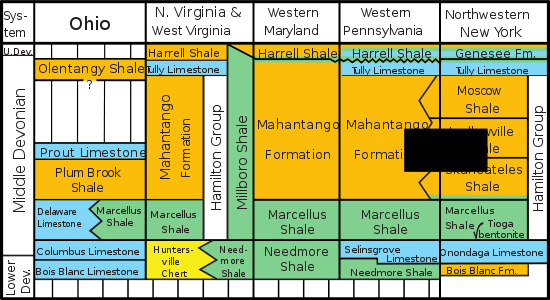- Mahantango Formation
-
Mahantango Formation
Stratigraphic range: Middle Devonian, ~387 MaType Geological formation Unit of Hamilton Group Sub-units See: Description Underlies Harrell Shale Overlies Marcellus Formation Lithology Primary Shale Other Limestone, Siltstone Location Named for Mahantango Creek Region Appalachian Basin of
eastern North AmericaExtent New York to Maryland The Devonian Mahantango Formation is a mapped bedrock "unit" in Pennsylvania, New Jersey, New York and Maryland. It is named for the North branch of the Mahantango Creek in Perry and Juniata counties in Pennsylvania. It is a member of the Hamilton Group, along with the underlying the Marcellus Formation Shale.[1] South of Tuscarora Mountain in south central Pennsylvania, the lower members of this unit were also mapped as the Montebello Formation.[2]
Contents
Description
The Mahantango is defined as a gray, brown, and olive siltstone and shale,[3] characterized by coarsening-upward cycles.[1] It is typically found conformally overlying the Marcellus Formation, and underlying the Tully Limestone (where present).[4]
The Mahantango has been divided into four members:[5]
- Tully Limestone: a fossiliferous calcaerous shale. The Tully is a conspicuous formation, which separates the Mahantango from the Hamilton Group.[6]
- Sherman Rdge: Olive gray, fossiliferous, claystone and siltstone with interbedded fine sandstones coarsening upward. sandstone.
- Montebello Sandstone: Olive gray, fossiliferous, coarse to fine-grained sandstone, interbedded with siltstone and claystone, in coarsening upward cycles.
- Fisher Ridge (also described as the Dalmatia and Turkey Ridge): a Silty Claystone, siltstone, and very fine-grained sandstone.
The Sherman Ridge and Fisher Ridge are ridge-formers.[7]
In south-central Pennsylvania, the Mahantango includes the Clearville, Frame, Chaneysville, and Gander Run Members.
Depositional environment
The Mahantango represents a terrestrial to marine transition zone that went through many transgressive-regression sequences. The fine-graned rocks represent a shallow sea environment and accounts for many of the fossils. Coarser grained sediments represent near-shore environments, beaches, or possibly delta lobes. These environments were tide-dominated and often had violent storms. The Montebello Sandstone member is an example of a storm dominated rock unit. Brachiopod fossils are scattered in massive sandstone beds throughout the rock unit, while the Sherman Ridge member is more laminated with fossilized ripple marks often indicating tidal current directions.[8]
Fossils
 Enrolled Phacops rana from an outcrop of the Mahantango near Milesburg, Pennsylvania, with schizochroal eye visible
Enrolled Phacops rana from an outcrop of the Mahantango near Milesburg, Pennsylvania, with schizochroal eye visible
There are numerous marine fossils found in the Mahantango including Brachiopod, Crinoid, Trilobite, Bivalve, and Bryozoan.
Age
Relative age dating of the Mahantango places it in the Middle Devonian period, being deposited between 392 to 385 (±3) million years ago. It rests conformably a top the Marcellus Formation shale. Its upper contact is also conformable to the Trimmners Rock Formation and Harrell Shale.[9]
Economic Uses
References
- ^ a b "Explanation of Geologic Units". Pennsylvania Geological Survey. http://www.dcnr.state.pa.us/topogeo/map1/explanation.pdf. Retrieved 2008-01-26.
- ^ Pennsylvania Geological Survey, Fourth Series. Geologic Map of the Mifflintown Qd. (Map). 1:24,000. Cartography by United States Geological Survey. A126.
- ^ Berg, T.M., Edmunds, W.E., Geyer, A.R. and others, compilers, (1980). Geologic Map of Pennsylvania: Pennsylvania Geologic Survey, Map 1, scale 1:250,000.
- ^ a b Milici, Robert C.; Swezey, Christopher S. (2006). "Assessment of Appalachian Basin Oil and Gas Resources: Devonian Shale–Middle and Upper Paleozoic Total Petroleum System". Open-File Report Series 2006-1237. United States Geological Survey. http://pubs.usgs.gov/of/2006/1237/of2006-1237.pdf. Retrieved 2008-04-05.
- ^ MacLachlan, D.B., hoskins, D.M., Payne, D.F., (1995). Bedrock Geology of the Freeburg 7.5 minuet Quadrangle, Snyder County, Pennsylvania. ORF 95-04, The Pennsylvania Geologic Survey, Harrisburg, PA.
- ^ Milici, Robert C.; Swezey, Christopher S. (2006). "Assessment of Appalachian Basin Oil and Gas Resources: Devonian Shale–Middle and Upper Paleozoic Total Petroleum System". United States Geological Survey. http://pubs.usgs.gov/of/2006/1237/of2006-1237.pdf. Retrieved 2008-04-05.
- ^ "Paleozoic Stratigraphic Column of Central Pennsylvania" (pdf). Bucknell University. http://www.bucknell.edu/Documents/Geology/PaleozoicStratigraphicColumn1.pdf. Retrieved 2008-05-26.
- ^ Prave, A.R., Duke, W.L., Slattery, W. (1996). A depositional model for storm- and tide-dominated prograding siliciclastic shorelines from the Middle Devonian of the central Appalachian foreland basin, USA. Sedimentology, 43, 611-629.
- ^ Berg, T.M., et al., (1983). Stratagraphic Correlation Chart of Pennsylvania: G75, Pennsylvania Geologic Survey, Harrisburg, Pennsylvania.
See also
Categories:- Geologic formations of the United States
- Geology of New York
- Geology of Pennsylvania
- Geology of New Jersey
- Geology of Maryland
- Shale
- Siltstone
- Cliff-formers
Wikimedia Foundation. 2010.

